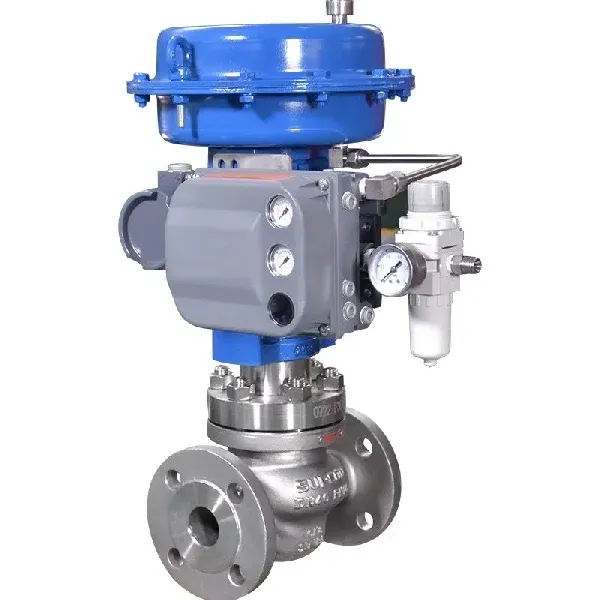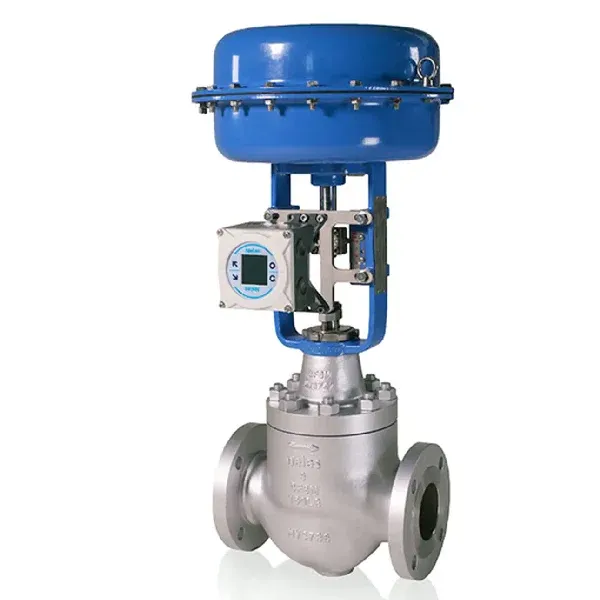A globe control valve is a type of valve designed to regulate the flow of process fluids in a pipeline. It operates using a linear motion mechanism, where a closure member (such as a plug or disc) moves into and out of a seating surface to control the flow. The valve body is characterized by a globular-shaped cavity around the port region, which gives it its name. Globe control valves are widely used in industrial applications to manage flow rates, pressure, and temperature in various processes. They are often paired with an actuator assembly to automate their operation.
One of the key features of globe control valves is their versatility. Many single-seated valve bodies incorporate a cage or retainer-style construction. This design serves multiple purposes: it retains the seat ring, guides the valve plug, and allows for the customization of flow characteristics. By changing the trim parts, the valve's flow characteristics can be modified to achieve reduced-capacity flow, noise attenuation, or the reduction or elimination of cavitation. This adaptability makes globe control valves suitable for a wide range of industrial applications.
A single-seat globe control valve is a type of globe valve that features a single plug and seat arrangement. The trim (the internal components that control flow) is interchangeable within the valve body, allowing for customization to suit different process requirements. By replacing the trim components, the valve can be adapted to handle various types of liquids and process conditions.

Single-seat globe control valves are among the most commonly used control valves due to their simple structure and reliable performance. They are particularly well-suited for applications requiring tight shut-off and precise flow control. These valves are capable of handling a wide range of fluid services, including liquids, gases, and steam. The maximum flow rate can be controlled by adjusting the size of the plug and seat ring, while the fluid characteristics can be fine-tuned by modifying the shape of the plug's curved surface.
Single-seat globe control valves are ideal for applications where leakage must be minimized, such as in high-pressure or high-temperature systems. However, they are less suitable for applications with high-pressure drops due to the unbalanced forces acting on the plug.
Single-seat globe control valves have a straightforward design, making them easy to maintain and repair. The valve body typically features a single plug and seat arrangement, which simplifies the internal structure. However, this design also results in significant unbalanced forces when the valve is exposed to high-pressure fluids. The fluid pressure acts on the entire area of the plug, creating a large unbalance force that must be counteracted by the actuator. As a result, single-seat valves have lower allowable pressure drops compared to valves with balanced trim designs.
Despite this limitation, single-seat globe control valves are widely used in applications where tight shut-off is critical. Their simple structure and ease of maintenance make them a popular choice for many industrial processes.
A cage-guided globe control valve is a type of straight-stroke control valve that features a cage structure to guide the plug and control flow. Like single-seat valves, the trim in cage-guided valves is interchangeable, allowing for customization to meet specific process requirements. The cage-guided design is particularly effective in high-pressure drop applications, where it helps reduce the effects of cavitation and noise.
The cage structure also provides excellent interchangeability, enabling users to achieve different flow characteristics by replacing the cage. This flexibility makes cage-guided valves highly versatile and capable of delivering precise control in demanding industrial processes.

Cage-guided control valves are commonly used in sizes ranging from 1 to 12 inches and are typically paired with a standard diaphragm-type actuator. They are suitable for a wide range of industrial applications, including those involving high-pressure drops, cavitation, and noise. The valve's metal seat allows it to operate in temperatures ranging from -196°C to +538°C, while a soft seat extends the temperature range to -45°C to +200°C.
These valves are ideal for processes that require precise flow control, noise reduction, and cavitation mitigation. Their ability to handle high-pressure drops makes them a preferred choice for applications in industries such as oil and gas, power generation, and chemical processing.
The cage-guided control valve features a balanced design, which sets it apart from single-seat valves. The cage structure includes balance ports that help reduce the unbalance force acting on the plug. This design allows the valve to be paired with a smaller actuator, making it more efficient and cost-effective.
One of the simplest cage-guided valve designs is the twin-seat structure, which is suitable for applications where leakage is not a critical concern. However, for applications requiring tight shut-off, the cage-guided single-seat control valve is the preferred choice. This design incorporates a sliding seal between the plug and the cage, preventing upstream fluid from leaking into the downstream system. As a result, cage-guided single-seat valves offer both tight shut-off capabilities and balanced performance.
Single Seat Globe Control Valve: Features a simple design with a single plug and seat arrangement. The trim is interchangeable, allowing for customization of flow characteristics. However, the single-seat design results in significant unbalanced forces, limiting its suitability for high-pressure drop applications.
Cage Guided Globe Control Valve: Incorporates a cage structure to guide the plug and balance the forces acting on it. The cage design reduces unbalance forces, allowing for the use of a smaller actuator. The trim is also interchangeable, providing flexibility in flow characteristics and performance.
Single Seat Globe Control Valve: Offers tight shut-off capabilities, making it ideal for applications where leakage must be minimized. However, its performance is limited in high-pressure drop scenarios due to the unbalanced forces acting on the plug.
Cage Guided Globe Control Valve: Excels in high-pressure drop applications, where it effectively reduces cavitation and noise. The balanced design allows for precise control and efficient operation, even in demanding conditions.
Single Seat Globe Control Valve: Best suited for applications requiring tight shut-off and precise flow control in low to moderate pressure drop scenarios. Commonly used in industries such as water treatment, HVAC, and general process control.
Cage Guided Globe Control Valve: Ideal for high-pressure drop applications, such as those found in the oil and gas, power generation, and chemical processing industries. Its ability to handle cavitation and noise makes it a versatile choice for demanding processes.
Single Seat Globe Control Valve: Easy to maintain and repair due to its simple design. The interchangeable trim allows for customization, but the valve's performance is limited by its single-seat structure.
Cage Guided Globe Control Valve: Offers excellent interchangeability, with the ability to achieve different flow characteristics by replacing the cage. The balanced design reduces wear and tear, resulting in longer service life and lower maintenance costs.
Both single-seat and cage-guided globe control valves have their unique advantages and limitations. Single-seat valves are ideal for applications requiring tight shut-off and precise flow control in low to moderate pressure drop scenarios. Their simple design and ease of maintenance make them a popular choice for many industrial processes.
On the other hand, cage-guided valves are better suited for high-pressure drop applications, where they excel in reducing cavitation and noise. Their balanced design allows for precise control and efficient operation, making them a preferred choice for demanding industrial processes.
Ultimately, the choice between single-seat and cage-guided globe control valves depends on the specific requirements of the application. By understanding the strengths and limitations of each type, engineers and operators can select the right valve to optimize their processes and achieve reliable performance.